When considering waterproof pendant lights for outdoor spaces, focus on fixtures with high IP ratings, ideally IP65 or above, to ensure durability against water exposure. Materials like stainless steel, aluminum, and polymers provide excellent weather resistance. Stylish options range from rustic lantern designs to modern minimalism, catering to diverse aesthetics. Sizing and placement are crucial for functionality, while proper maintenance ensures longevity. Explore a variety of trendy designs for a touch of elegance in outdoor settings.
Key Takeaways
- Choose pendant lights with a minimum IP44 rating for adequate water resistance in outdoor settings.
- Consider materials like stainless steel and powder-coated aluminum for durability against weather elements.
- Look for fixtures designed with rustic lantern styles or modern minimalist designs that suit your outdoor aesthetics.
- Ensure proper sizing and placement for optimal illumination—like hanging pendants 30 to 36 inches above dining surfaces.
- Regular maintenance, such as cleaning and checking connections, ensures longevity and performance of outdoor pendant lights.
IP Ratings to Consider for Outdoor Pendant Lights
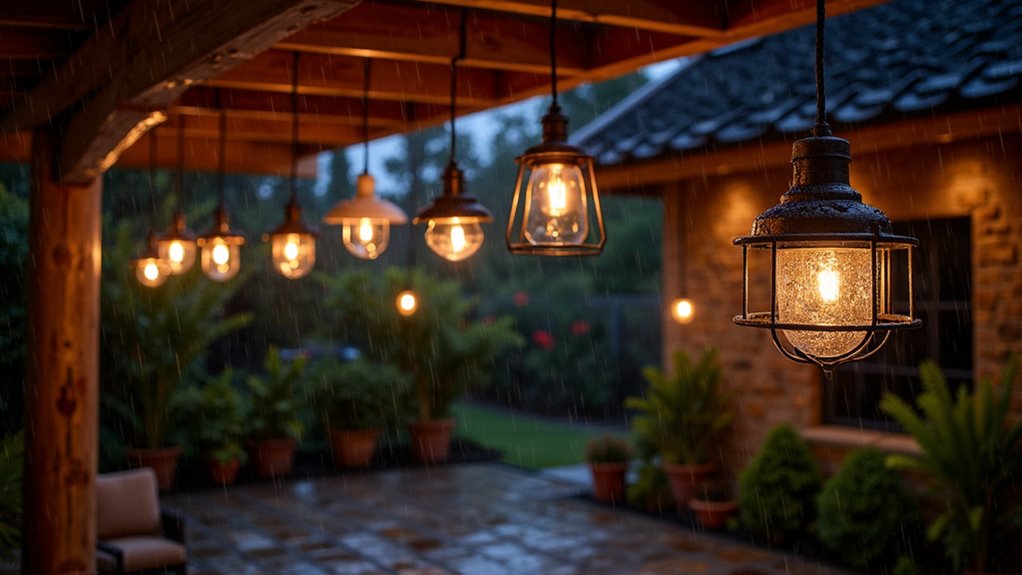
When choosing outdoor pendant lights, understanding IP ratings is essential, as they provide critical insights into a fixture’s ability to withstand environmental challenges. The IP rating system, comprising two digits, indicates waterproof ratings alongside solid protection against dirt and debris. The first digit ranges from 0 to 6, where a rating of 6 ensures complete dust tightness, safeguarding internal components from outdoor contaminants. A higher IP rating, such as IP65 or above, denotes that the fixture is waterproof and suitable for diverse weather conditions. The second digit denotes liquid ingress protection, with higher numbers signifying better resistance to water exposure. For outdoor spaces, a minimum of IP44 is advisable for adequate waterproof ratings against splashes, while higher ratings like IP65 offer enhanced durability against low-pressure water jets. Such distinctions are crucial for ensuring the longevity and functionality of outdoor pendant lights. Additionally, lights with higher IP ratings are recommended for outdoor use, as they provide better assurance against both dust and moisture intrusion.
Best Materials for Weather Resistance

Choosing the right materials for outdoor pendant lights is paramount to ensure their longevity and resilience against the elements. Metals like stainless steel and bronze offer exceptional corrosion resistance, ideal for coastal environments, due to their robust alloy compositions.
Aluminum, when powder-coated, provides an economical option while retaining durability. In contrast, polymers such as polycarbonate and acrylic excel in impact resistance and UV protection, crucial for outdoor settings. Additionally, materials like Vivex deliver strength against corrosive environments.
When considering the environmental impact, responsible material sourcing plays a vital role, ensuring that the chosen materials contribute to sustainable practices. These selections not only enhance aesthetic appeal but fortify durability against nature’s challenges, providing a lasting solution for outdoor lighting.
Stylish Outdoor Pendant Light Designs
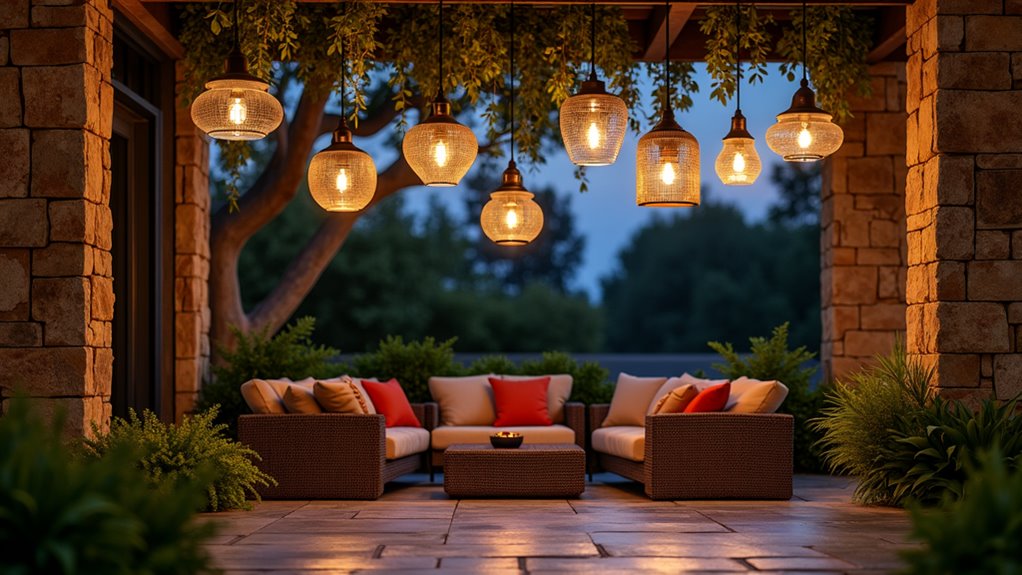
The realm of outdoor pendant light designs showcases a captivating interplay between rustic elegance and modern simplicity.
Rustic lantern styles exude warmth through natural materials and vintage finishes, while modern minimalist designs emphasize sleek lines and geometric forms for a contemporary appeal.
Nature-inspired textures further enhance the aesthetic, creating a harmonious blend that complements various outdoor environments.
Rustic Lantern Styles
Rustic lantern styles offer a timeless charm, seamlessly blending vintage aesthetics with modern functionality. Characterized by designs reminiscent of historical elements, these fixtures evoke a classic farmhouse feel, making them perfect for outdoor spaces.
Common materials include durable metals like wrought iron and brass, often paired with glass shades that feature seeded or frosted finishes to diffuse light beautifully. The design elements typically incorporate classic lantern shapes, caged designs, and visible hardware, enhancing their rustic charm.
Functionally, they provide essential illumination for safety while creating an inviting atmosphere for gatherings. When selecting rustic lanterns, it’s crucial to ensure they are rated for outdoor use and complement the existing architecture of the home.
Modern Minimalist Designs
Embracing a sleek and contemporary aesthetic, modern minimalist designs have transformed outdoor pendant lighting into a blend of form and function. Characterized by clean lines and uncluttered silhouettes, these fixtures often emphasize geometric light shapes such as cylinders, cubes, and rectangular forms.
Eschewing excessive ornamentation, modern designs prioritize simplicity and functionality, often featuring minimalist color palettes like black, white, and metallic finishes for a striking appeal. Materials such as durable aluminum, stainless steel, and weather-resistant plastics ensure both longevity and a refined look.
Integrated LED technology enhances energy efficiency, while adjustable hanging heights accommodate various outdoor settings. These sophisticated lights not only illuminate spaces but also serve as sculptural elements, enhancing the ambiance of any modern environment.
Nature-Inspired Textures
Nature-inspired textures have emerged as a captivating trend in outdoor pendant lighting, seamlessly merging aesthetic appeal with the organic essence of the environment. Designs incorporating rattan, bamboo, wood, and stone elements evoke warmth and charm while ensuring durability.
| Material | Key Features | Ideal Locations |
|---|---|---|
| Rattan | Hand-woven, lightweight, moisture-resistant | Covered patios, outdoor lounges |
| Bamboo | Eco-friendly, weather-resistant | Dining areas, alfresco environments |
| Wood (and Wood-Look) | Rustic aesthetics, waterproof | Entryways, farmhouses |
Rattan weaving techniques create both beauty and structural integrity. Meanwhile, bamboo durability comparisons show that treated designs can resist elements, making both options suitable for long-lasting outdoor elegance.
Essential Features for Outdoor Lighting
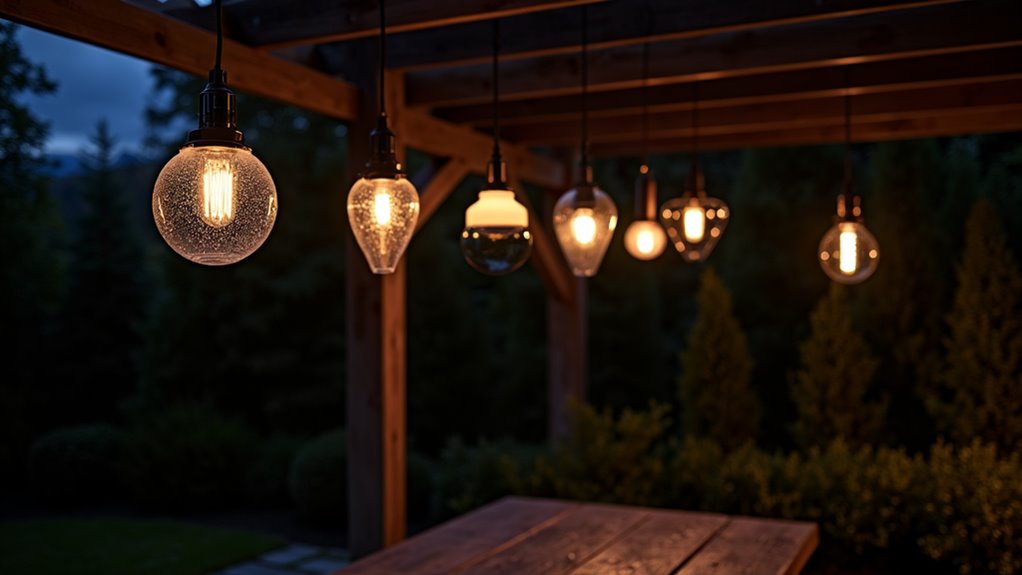
When selecting outdoor lighting, understanding IP ratings and material weather resistance is crucial for ensuring long-lasting performance.
An appropriate IP rating protects fixtures from dust and water exposure, while high-quality materials, such as corrosion-resistant metals, enhance durability in harsh environments.
This combination ensures that outdoor pendant lights remain both functional and aesthetically pleasing, regardless of the elements they face.
IP Rating Importance
How can one ensure the longevity and safety of outdoor lighting fixtures? Understanding IP rating standards is essential.
The Ingress Protection (IP) rating indicates how effectively a fixture is sealed against both solid particles and moisture. For outdoor lighting safety, choosing lights with appropriate IP ratings can prevent potential hazards related to dust and water exposure.
An IP44 rating is the minimum recommendation, guarding against dust ingress larger than 1mm and water splashes. Outdoor fixtures with IP65 or higher offer complete dust protection and resistance to water jets, crucial for enduring harsh weather conditions.
Selecting the right IP rating not only enhances durability but also dictates safe installation locations, ensuring that outdoor lighting can withstand the elements.
Material Weather Resistance
Choosing the right materials for outdoor lighting fixtures is crucial in ensuring their durability and performance against various environmental challenges.
Metal options like aluminum, stainless steel, and brass provide significant weather resistance, each with unique material benefits, such as corrosion durability in coastal settings.
Plastics such as polycarbonate and ABS offer lightweight, impact-resistant choices ideal for outdoor conditions.
Though glass provides aesthetic appeal, its vulnerability requires attention.
To enhance weather resistance, coatings like powder coating protect metallic surfaces from oxidation, while UV stabilizers for plastics help maintain integrity against sun exposure.
Ultimately, selecting weather-resistant materials ensures that outdoor pendant lights not only endure but also maintain their functionality and visual appeal throughout varying weather conditions.
Sizing Your Outdoor Pendant Light

What factors contribute to properly sizing an outdoor pendant light?
First and foremost, fixture proportions must harmonize with surrounding elements like doors or furniture. To avoid an awkward aesthetic, one should consider the visual weight of the fixture; larger spaces can accommodate bold designs, while compact areas suit smaller options.
For entryways, pendants should typically be 1/5 of the door height, while spaces above tables require fixtures to be 2/3 of the table width, adhering to spacing guidelines of 24 inches apart for multiple pendants.
Moreover, hanging clearance should be maintained at a minimum of 7 feet. Visualizing dimensions through sketches aids in ensuring that the selected light complements the outdoor environment effectively.
Optimal Placement for Maximum Illumination
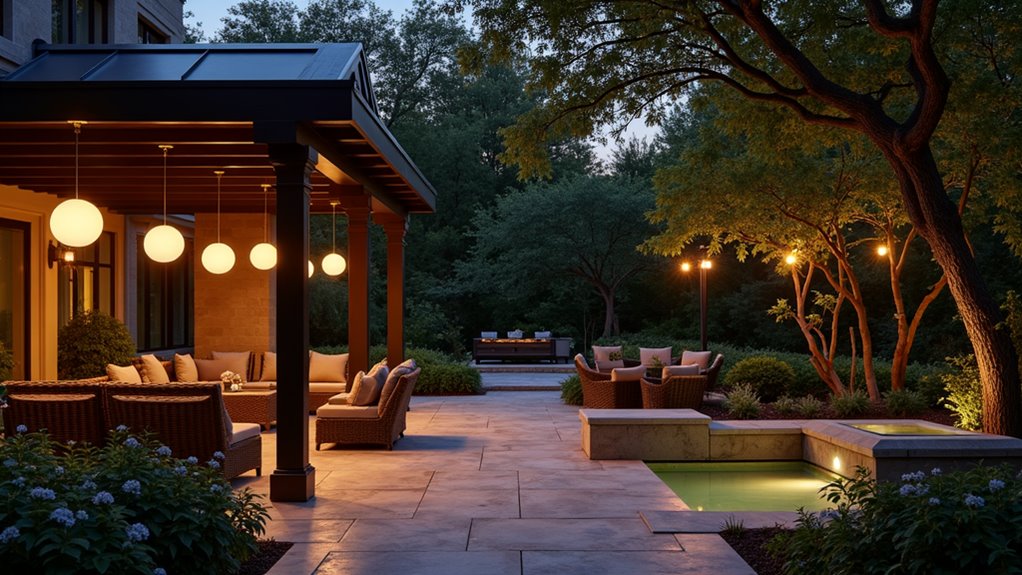
Proper placement of waterproof pendant lights is essential to achieve maximum illumination in outdoor settings.
Factors such as ceiling height are critical in determining hanging distances, while targeted lighting can enhance focal areas like dining spaces.
Additionally, ensuring adequate light near pathways not only enhances safety but also invites a warm ambiance throughout the outdoor environment.
Ceiling Height Considerations
While selecting the ideal height for pendant lights in outdoor spaces, it is crucial to consider the interplay between ceiling height and illumination. For optimal effectiveness, pendants should typically hang 7 to 8 feet from the floor, ensuring adequate clearance.
In settings with ceiling height variation, adjustments are key; for every additional foot, extend the pendant length by 3-6 inches to maintain proportionality.
In dining areas, the ideal distance is 30 to 36 inches above surfaces, striking a balance between light spread and visual comfort.
Furthermore, larger fixtures may require higher placements to avoid overwhelming the space, while multiple pendants should be spaced at least 24 inches apart to enhance light distribution and aesthetic appeal.
Focal Area Lighting
Selecting the right height for pendant lights sets the stage for effective illumination, but optimal lighting goes beyond mere placement; it involves recognizing and accentuating focal areas in outdoor spaces. Key architectural features and outdoor structures, such as columns and gazebos, benefit from dedicated lighting to enhance their aesthetic appeal.
Placing pendants directly over dining and seating areas ensures functionality while contributing to overall ambiance. Employing layered lighting strategies, such as combining pendants with wall sconces, adds depth and warmth.
Clustering pendants creates a striking visual centerpiece, while careful height adjustments—between 30-36 inches above tables—provide both comfort and illumination.
Ultimately, thoughtful placement catalyzes focal area enhancement, fostering inviting atmospheres for relaxation and socializing under the stars.
Pathway Safety Placement
To ensure safe navigation in outdoor spaces, careful consideration of pathway light placement is crucial for achieving optimal illumination.
Proper spacing of pathway lights, typically between 5 to 15 feet depending on fixture type, enhances pathway visibility and eliminates dark spots. For best results, light beams should gently overlap, while fixtures should be installed 14 to 24 inches above the ground to avoid glare and ensure clear illumination.
Staggering lights on either side of the path provides a more inviting, natural glow. Additionally, considerations like motion sensors and dedicated step lights can further increase safety by highlighting changes in elevation.
Ultimately, strategic placement transforms pathways into secure, well-lit areas conducive to safe navigation.
Installation Tips for Outdoor Lighting
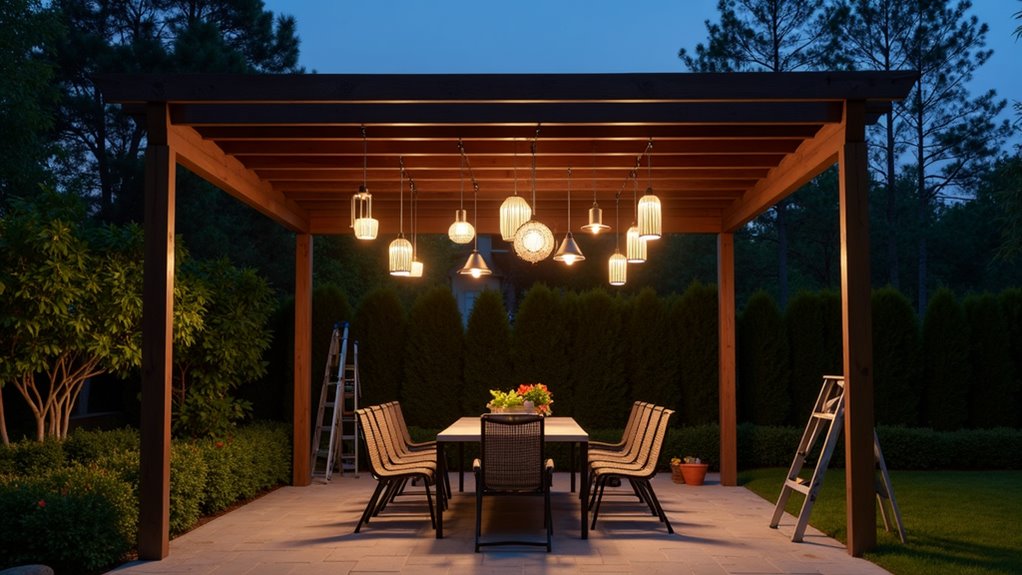
Carefully planning the installation of outdoor lighting can significantly enhance both the aesthetics and safety of a property.
Beginning with a detailed lighting layout, property owners should sketch the design, specifying fixture placement based on their intended function, whether for security or accentuating features.
A well-thought-out lighting layout is crucial for effective fixture placement, enhancing both security and design elegance.
Safety during installation is paramount; always turn off the main power and confirm circuits are dead before beginning work. Utilizing outdoor-rated fixtures and GFCIs is essential, particularly near water.
When laying low-voltage cables, trench depth should be 3-6 inches to protect wiring. Secure connections with waterproof connectors, ensuring compliance with local regulations.
Maintenance Tips for Outdoor Pendant Lights
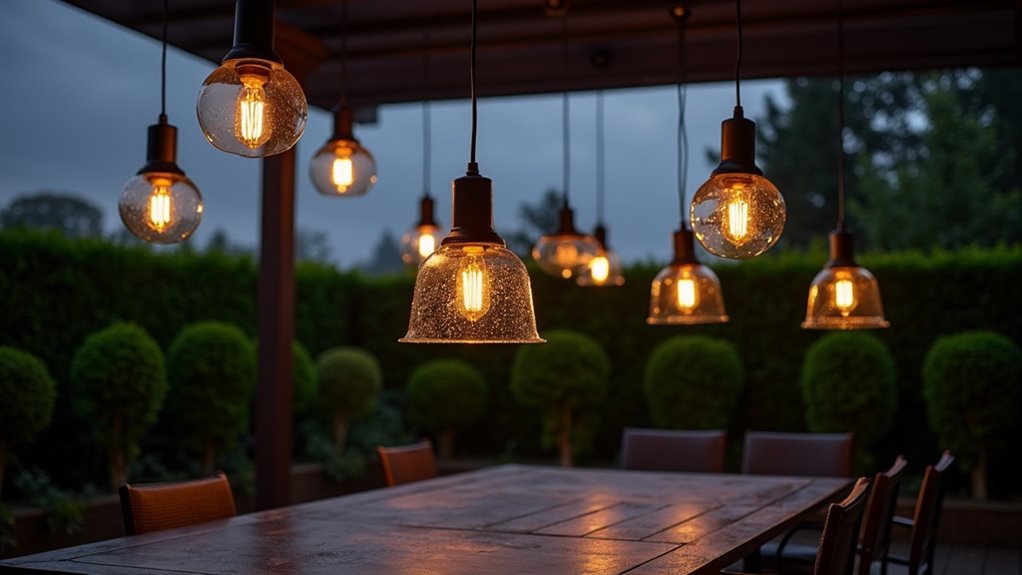
Maintaining outdoor pendant lights is essential for ensuring their longevity and optimal performance. Regular cleaning protocols and routine inspections help identify potential issues early, allowing for preventative measures. Below is an inspection checklist to guide homeowners in the maintenance process:
| Task | Frequency | Notes |
|---|---|---|
| Inspect for damages | Monthly | Look for cracks and loose parts |
| Clean fixtures | Every 2-3 months | Use mild soap; avoid abrasives |
| Check electrical connections | Monthly | Ensure there are no frays or issues |
| Apply protective coatings | Annually | Use clear lacquer or silicone |
| Rinse fixtures in coastal areas | Monthly | Remove salt buildup to prevent corrosion |
Utilizing effective cleaning techniques and following this checklist optimizes performance, enhances aesthetics, and prolongs the life of outdoor pendant lights.
Energy-Efficient Options for Modern Spaces
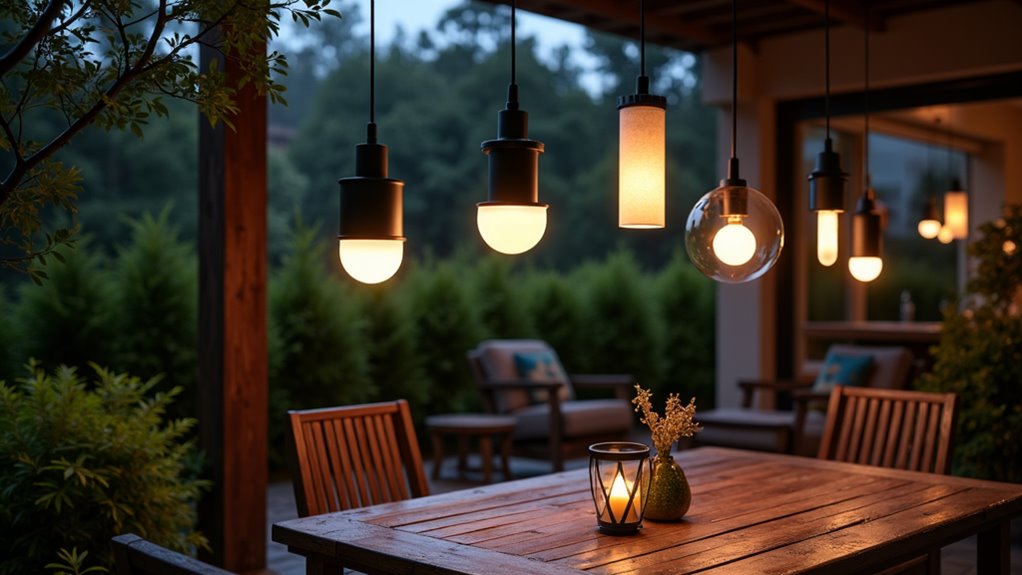
Outdoor pendant lights not only enhance the aesthetic appeal of modern spaces but also play a pivotal role in energy efficiency. Incorporating energy efficient technologies, these fixtures primarily utilize LED technology, consuming 75% less energy than traditional incandescent bulbs. Their longevity minimizes waste, and average wattage ranges from just 10-15 watts.
Smart lighting integration further amplifies energy savings through automation, with features like remote control, programmable schedules, and dimming capabilities that adapt to users’ needs. Additionally, ENERGY STAR certifications and IP65 ratings ensure optimal performance and sustainability.
Trending Styles for Outdoor Areas

As homeowners look to elevate their outdoor spaces, trending styles increasingly emphasize a harmonious blend of natural aesthetics and modern sensibilities.
Emphasizing warmth, outdoor areas are adorned with eco-friendly options using materials like rattan, bamboo, and reclaimed wood, enhancing cozy, organic vibes. Earthy color palettes—featuring warm neutrals and pops of deep greens—serve as versatile backdrops for vibrant accents.
Meanwhile, curves and organic shapes dominate furniture design, echoing nature’s diversity while ensuring safety for families. The seamless flow between indoor and outdoor spaces is achieved through chic, durable lighting that complements modern interiors.
With these design elements, homeowners create stunning, functional outdoor rooms that reflect a commitment to sustainability and style.


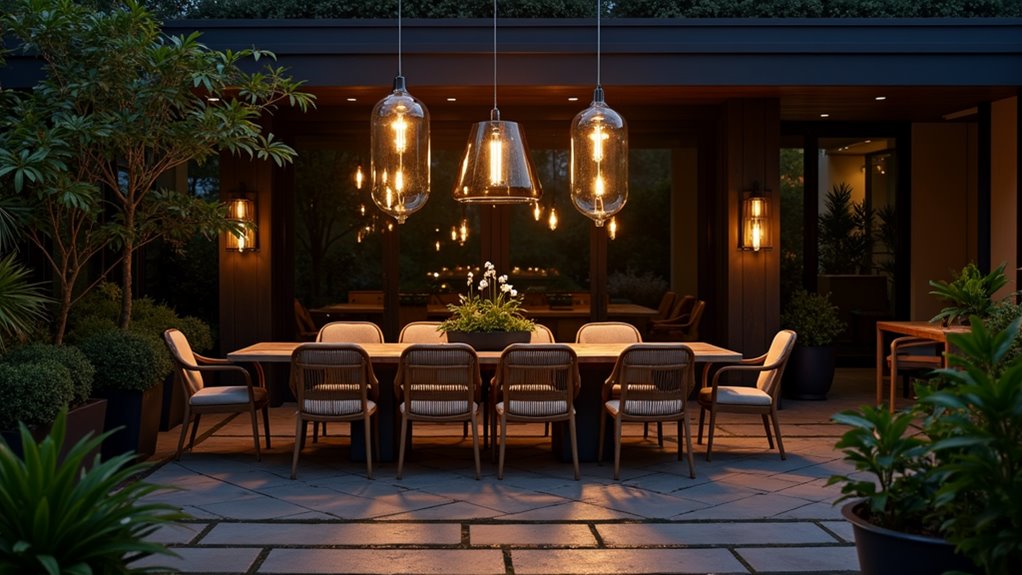
Bài viết cùng chủ đề:
7 Stunning Nordic Style Pendant Lights for Your Home
Top 3 Blown Glass Globe Pendant Lights for Your Home
Top 10 Down Rods for Pendant Lights in 2025
Top 3 Island Bench Pendant Lights for Your Kitchen
7 Stunning Dome Kitchen Pendant Lights for Your Home
How Big Should Pendant Lights Be Over a Kitchen Island?